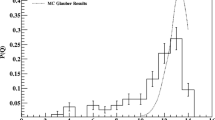Abstract
Nuclear fragmentation and its possible connection to a critical phenomenon or phase transition have been the subject of intense theoretical and experimental research on the interactivity of relativistic heavy nuclei. Relativistic heavy-ion collisions enable studies of the extended state of matter at density and temperature extremes only achieved in the hot early Universe. A significant barrier to knowing the mechanism of nucleus–nucleus interactions is the study of the processes that take place in the spectator and participant regions of interacting nuclei, and in particular, the interplay between these processes. In the present work, we have studied the multiplicity distribution of the slowest target fragments (black particles), and their dependence on the interaction of different target nuclei of emulsion. We have also study the correlation of the multiplicity distribution as a function of the collision geometry. The results are compared with other experimental data as per availability. This study reveals a striking relationship between the target fragmentation processes and collision geometry with multiplicity distributions.






Similar content being viewed by others
References
S. Kamel et al., Emission characteristics of target black fragments in 16O-Emulsion collisions at 3.7 A GeV. Int. J. Mod. Phys. E 30(6), 2150042 (2021)
S. Kumar et al., Characteristics of the grey particles emission at relativistic energy. Eur. Phys. J. Plus 136, 115 (2021)
B. Kumari et al., Emission feature of the shower particles produced in backward hemisphere in the interaction of 84Kr36 +Em at 1 A GeV. Int. J. Mod. Phys. E 31(6), 2250061 (2022)
Kajal et al., Emission feature of the singly-charged and doubly-charged projectile fragments emitted in the interaction of 84Kr36 +Em at 1 GeV per. Int. J. Mod. Phys. E 31(8), 2250073 (2022)
M.K. Singh et al., Study of emission characteristics of the projectile fragments produced in the interaction of 84Kr36 with nuclear emulsion detector at 1 GeV. Chin. J. Phys. 67, 107 (2020)
N. Marimuthu et al., Study of relativistic charged particles production in 84Kr36 emulsion interactions ∼ 1 GeV per nucleon with wounded nucleon model. Int. J. Mod. Phys. E 28(8), 1950058 (2019)
M.K. Singh et al., Multiplicity characteristics of target fragments and shower particles with noninteracting projectile nucleons emitted in 84Kr–Em interaction at 1 A GeV. Eur. Phys. J. Plus 136, 419 (2021)
U. Rawat et al., Emission characteristics of the shower particles produced in the interaction of 84Kr with emulsion 1 Gev per nucleon. J. Kor. Phys. Soc. 83, 411 (2023)
M.K. Singh et al., Multiplicity characteristics of target fragments and shower particles with noninteracting projectile nucleons emitted in 84Kr–Em interaction at 1 A GeV. Eur. Phys. J. Plus 28, 1523 (2021)
F.H. Liu, Emission of Relativistic Light Fragments in Nucleus-Emulsion Collisions at High Energy. Chin. J. Phys. 38, 1063 (2000)
F.H. Liu, Multiplicity Distribution of Relativistic Charged Particles in Oxygen-Emulsion Collisions at 3.7 A GeV. Chin. J. Phys. 41(5), 486 (2003)
M.K. Singh et al., Two source emission behavior of projectile fragments alpha in 84Kr interactions at around 1 GeV per nucleon. Indian J. Phys. 85, 1523 (2011)
M. K. Singh, Energy Dependence Study of Projectile Fragmentation of 84Kr36+ Emulsion Interactions Ph.D. Thesis, VBS Purvanchal University, Jaunpur, India, (2014)
M. K. Singh et al., Charge Measurement / Estimation Techniques in Nuclear Emulsion Detector. J. Sci. Res., BHU, 63, 249 (2019)
M.K. Singh et al., Characteristics of alpha projectile fragments emission in interaction of nuclei with emulsion. Indian J. Phys. 84, 1257 (2010)
A. Kumar et al., Characteristics of disintegration of different emulsion nuclei by relativistic28Si nuclei at 3.7 A GeV. Pramana. J. Phys. 84(4), 591 (2015)
M.A. Ahmad et al., General Characteristics of Heavy Ion Collisions at the Energy of 14.6 A GeV. Int. J. Theo. Appl. Phys. 2, 199 (2012)
Acknowledgements
The technical team at GSI in Germany, which exposed the nuclear emulsion detector to the \(^{84}Kr\) beam at 1 A GeV, is gratefully acknowledged by the authors.
Author information
Authors and Affiliations
Corresponding author
Additional information
Publisher's Note
Springer Nature remains neutral with regard to jurisdictional claims in published maps and institutional affiliations.
Rights and permissions
Springer Nature or its licensor (e.g. a society or other partner) holds exclusive rights to this article under a publishing agreement with the author(s) or other rightsholder(s); author self-archiving of the accepted manuscript version of this article is solely governed by the terms of such publishing agreement and applicable law.
About this article
Cite this article
Kumari, B., Singh, M.K. & Singh, R. Emission characteristics of the slowest target protons produced in the interaction of \(^{84}Kr\) nuclei with emulsion nuclei at 1 A GeV. J. Korean Phys. Soc. (2024). https://doi.org/10.1007/s40042-024-01071-1
Received:
Revised:
Accepted:
Published:
DOI: https://doi.org/10.1007/s40042-024-01071-1




